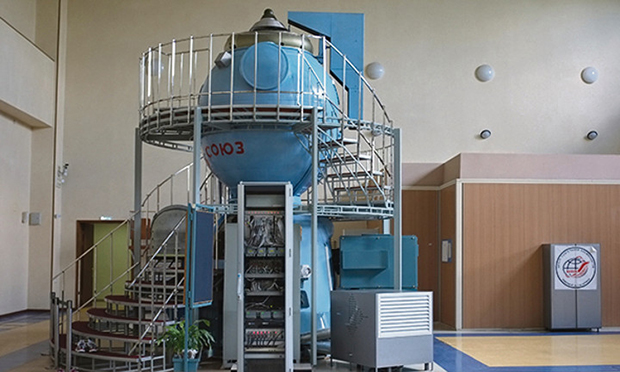
Russia’s relationship with the UK is a strained one these days, with the crisis in the Crimea and any number of high profile incidents attesting to a deepening divide, culturally as well as politically, between the two countries.
But in Memorial Community Church’s Tower Gallery in Plaistow, a new image of Russia (or at least Moscow), has emerged. Here members of Map6 photography collective are holding The Moscow Project, five individual photography projects conducted on a week-long group trip to Moscow last year.
With minimal plans five group members each explored a different aspect of the city: its infrastructure, its architecture, the lie of the city and its secrets. The results, hung around a spiral stairwell leading up a belfry tower, are a feast for anyone interested in outsider perspectives.
Mitch Karunaratne, a primary school head teacher from Hackney, got access to Star City, a secretive and closed community 30 kilometres outside Moscow, where cosmonauts have trained from the 1950s to the present day.
“It’s a secretive base that doesn’t appear on maps and only recently began to accept its location, but you still arrive to it by train,” she describes. “On the platform there’s no station sign, there’s nothing. You walk through woods and suddenly you’re at this walled city which has apartments, schools, all sorts of stuff inside it as well as the [cosmonaut] training base.”
Getting in isn’t easy – Star City doesn’t take visitors. But through a friend of a friend of a friend – the son of an engineer on the Gargarin space programme – she managed it, posing as his non-Russian-speaking girlfriend.
One photograph shows a blue pressurised capsule, resembling something out of sixties science-fiction, being used as a simulator. “Inside the capsule there are two cosmonauts actually training. You can see the shoes they’ve taken off at the side,” says Karunaratne, pointing to some discarded trainers. Another shot shows the outside of a room thought to contain the Mir space station. “It’s being used as a training facility now,” she adds.
Karunaratne, the group’s spokesperson elect, gives me a guided tour of the exhibition. Chloe Lelliott’s project, Subterraneans, is about the Moscow metro, built in the time of Stalin. The stations are known as ‘the people’s palaces’ for their opulent design and grand structures. Lelliot was underground all day for a week, and experienced no restrictions on taking photos. “She was just amazed at just how many people hung out in the subway as well as the beautiful architecture that’s down there,” says Karunaratne.
The wide boulevards and the weather are two reasons why Muscovites may prefer life underground. Heather Shuker set out to document the city’s ‘kiosk economy’, informal retail spaces lining underground passages that connect streets or stations. They appeared after the collapse of the Soviet Union but may soon vanish due to increasing numbers of shopping centres and their generally low stock among ruling elites. Usually they are big enough for just one person to stand in, and are run predominantly by women who often sell only one product, such as rubber bands, tights or skirts.
“People coming home from work would be trying clothes on and then she’d be showing you different colours and getting the mirror out. It was a proper shopping experience but underground,” says Karunaratne.
Paul Walsh is a walking photographer from Birmingham, who took photographs while walking the length of the Moscow circular line from above ground for his project Moscow Circular. This twenty kilometre ring allows trains to orbit the city centre continually, an action Walsh says reflects the cyclical nature of life above ground.
A great urban legend involves the construction of the line. When engineers designing the metro showed their plans to Stalin, he is said to have approved them before abruptly leaving the room, his cup of coffee left on the map. The engineers decided to build a line matching the brown ring left by his cup, in a move showing the ruler’s cult of personality as well as explaining why on maps the line is brown.
The Bolshevik October revolution of 1917 is a rough starting point for the birth of constructivist architecture, an approach that values the socialist principles of function and structure in buildings over aesthetics. David Sterry, himself an architect, photographed examples of early constructivism in his project, The Absence of Idle Elements, as well as later buildings and developments that rejected constructivism in favour of Stalin’s demands for an architecture that promotes prosperity.
People talk about getting lost in a city, but in London it is possible to find your way using tall buildings. In one photograph, by Paul Walsh, a man appears from a tunnel while in the background looms one of the ‘Seven Sisters’, a group of skyscrapers from the Stalin-era built in the ‘wedding cake’, gothic style. The buildings, symbols of Stalin’s power, are visible throughout the city, a reminder of the authoritarian nature of his regime.
Karunaratne explains that when the group went to Moscow in May last year they knew 2014 was going to be the British Concil Russian Year of Culture, but events in Crimea and the Sochi Winter Olympics have made the timing of the exhibition fortuitous, for in global politics Russia (and not Georgia) is always on our minds now.
This gives added substance to an exhibition already full of it. The Map6 collective, its members aged from 30-50, are people with a passion for taking photographs and who do it alongside their day jobs, though judging by the artistic standards on display this is hardly apparent.
The Moscow Project is at The Tower Gallery, 395 Barking Road, E13 8AL until 10 May.
